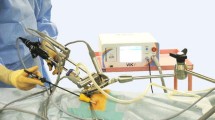Abstract.
Although the advantages of minimally invasive surgery (MIS) have been clearly established for the patient, the surgeon must cope with disadvantages caused by unergonomic instrument handles. Pressure areas and persisting nerve lesions have been described in the literature. The shape of the instrument handles has been identified as the reason for these disorders. To prevent these, it is necessary to use ergonomically designed handles for MIS instruments. Anatomic, physiologic, and ergonomic facts as well as the results of the authors' own experiences and tests are presented. On this basis, an ideal ergonomic working posture for the laparoscopic surgeon and an optimal grasp for manipulating the instruments' functional elements are recommended. To enable the surgeon to evaluate ergonomic handles for MIS instruments according to his own needs, 14 criteria for genuine ``ergonomic handles'' are established. On the basis of these criteria, deficiencies of handles currently available (ring and shank handles at an angle or with axial extension to the instrument shaft, and pistol handles) are discussed. Furthermore, new handles, developed by the authors according to the criteria for genuine ergonomic handles, are presented.
Similar content being viewed by others
Author information
Authors and Affiliations
Additional information
Received: 12 September 1997/Accepted: 28 May 1998
Rights and permissions
About this article
Cite this article
Matern, U., Waller, P. Instruments for minimally invasive surgery. Surg Endosc 13, 174–182 (1999). https://doi.org/10.1007/s004649900934
Published:
Issue Date:
DOI: https://doi.org/10.1007/s004649900934




